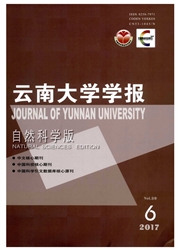

 中文摘要:
中文摘要:
了解桑寄生空间分布格局与群落寄主多样性、组成及相关性状的关系,对掌握物种间关系和群落结构有重要的生态学意义.研究采用样地调查法,对西双版纳不同种植模式种植园中桑寄生的感染率及寄生强度进行调查,比较了不同年龄阶段桑寄生的空间分布格局,分析了寄主性状与寄生感染率和寄生强度的相关性.结果显示,种植园内桑寄生呈现明显的聚集分布,且聚集强度随其年龄增加而减弱,与寄主树分布格局无关.桑寄生的感染率随树种多样性的增加分别为67.09%,66.35%和40.48%,呈下降趋势.桑寄生的感染率和寄生强度与寄主个体的高度、冠幅、胸径,及寄主多度(与感染率和寄生强度的相关系数r分别为0.409和0.455)呈正相关,表明桑寄生更偏好感染和聚集在较高大和优势度较高的寄主.作者认为在种植园建设和管理模式上,可通过增加树种多样性来降低桑寄生感染率,从而提高生产力和生产效益.
 英文摘要:
英文摘要:
The relationships between spatial distribution pattern of mistletoes and host species diversity, composition and related characteristics are critical to understand intraspecific relationship and forest community structure. To compare the infection prevalence ( proportion of hosts infected), infection intensity ( the mean numbers of mistletoes on every host tree) of mistletoe between polyculture and monoculture plantations, the spatial distribution of mistletoes in different plantations was investigated according to the plots surveys in Xishuangbanna, southwest China. The spatial structures of different mistletoe species in three different life stages ( seedling, juvenile and adult) in every plot were evaluated by aggregation index, the average crowding degree, Lloyd's patchiness index,and Morisita's dispersion index, etc. Pearson correlation and Spearman correlation were also used to analyze the relationship between infection intensity of mistletoes and the height, crown diameter, DBH, abundance of host trees. The results indicated that mistletoe infection prevalence decreased at 67.09 % ,66.35 % and 40.48% re- spectively by the increase of host trees diversity. The infection intensity of mistletoe was positively correlated with the height, crown diameter, DBH and abundance of host trees (r = 0.409 and 0.455 respectively), indicated that mistletoes prefers to infecting bigger host trees and hosts with higher dominance. It was found that mistletoes showed a clustered distribution pattern, and the degree of clustered decreased when mistletoes growing up. It was also suggested that to increase the diversity of the hosts in the plantation may be a good way to reduce mistletoe infection prevalence, and to increase the productivity and efficiency.
 同期刊论文项目
同期刊论文项目
 同项目期刊论文
同项目期刊论文
 期刊信息
期刊信息
